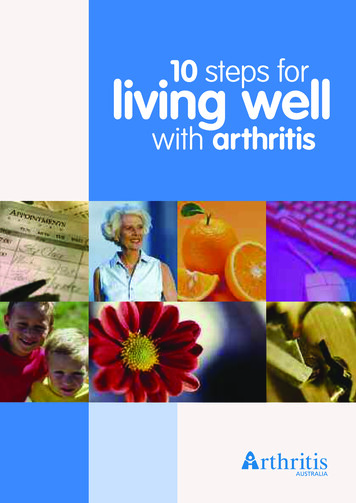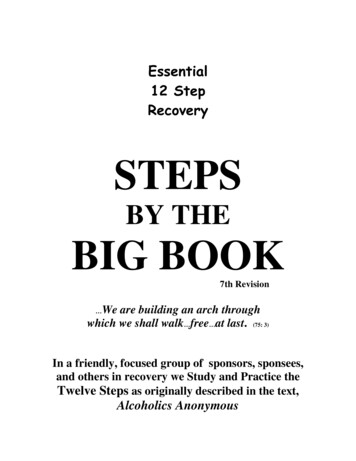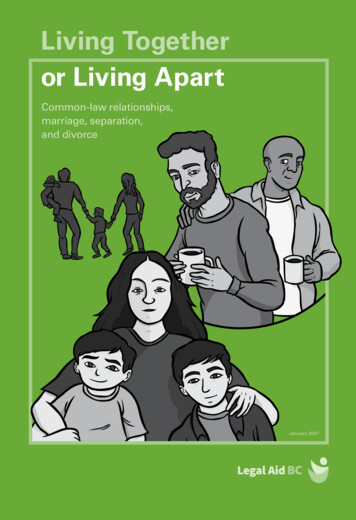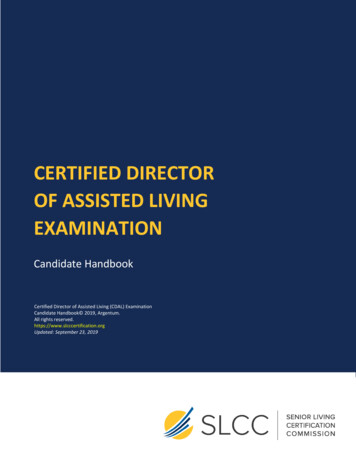
Transcription
10 steps forliving wellwith arthritis
› contentsIntroduction3Step 1Take control by knowing your diseaseArthritis - what is it? Osteoarthritis Rheumatoid arthritis Gout4Step 2Don’t delay, see your doctorWhat to expect Different types of tests9Step 3Work with your healthcare team and be an important part of itMaking the most of your healthcare team - some tips11Step 4Know about your treatment optionsPhysical therapies Medicines – an overview Complementary therapies13Step 5Find new ways to stay activeWhy exercise? What is the right exercise for arthritis?18Step 6Learn techniques to help manage your painSome pain management techniques22Step 7Acknowledge your feelings and seek supportDealing with depression and understanding your feelings24Step 8Make food choices that countOmega 3 oils Diet and gout27Step 9Balance your lifeHow to pace yourself31Step 10Call your local State or Territory Arthritis Office33More about using medicines safely34More about making informed decisions about treatments35Medical and consumer consultantsLisa Bywaters, Arthritis VictoriaTanya deKroo, National Resources CoordinatorMaggi Koerbin, Arthritis TasmaniaJacqui Louth, Arthritis NSWDr Mona Marabani, Rheumatologist andPresident of Arthritis Australia (2007 - 2010)Monte Scharbow, Arthritis ACTLouise Schnitzhofer, Arthritis NTMonica Tardinai, ConsumerAssoc Professor John York, Department ofRheumatology, Royal Prince Alfred Hospital Sydney Copyright Arthritis Australia 2004Reviewed June 2013Proudly supported by an educationalgrant from:10 steps for living well with arthritis2
› introductionArthritis is a very commoncondition in Australiaaffecting people of allages and from all walks oflife. Its symptoms oftenhave a big impact on thedaily lives of people.Although arthritis can be difficult tolive with, there are many simplemeasures that can help anyone witharthritis manage their symptoms andcope with daily life. They rely on inputfrom a number of people but the mostimportant person is you - the personwith arthritis.This book will put you on the path tomanaging your arthritis by taking anactive role in understanding andtreating your condition. By doing this,you will experience less pain and staymore active than those who feel thereis nothing they can do.The key steps listed on this page forma simple-to-follow check list for livingwell with arthritis. Read the rest ofthe information in this book to findout more about each of the steps and good luck on your journey tobetter living!1Take control by knowingyour disease2 Don’t delay, see your doctor3 Work with your healthcareteam and be an importantpart of it4 Know about your treatmentoptions5 Find new ways to stayactive6 Learn techniques to helpmanage your pain7 Acknowledge your feelingsand seek support8 Make food choices thatcount9 Balance your life10 Call your local State orTerritory Arthritis Office3introduction
› step oneTAKE CONTROL BY KNOWING YOUR DISEASEWith arthritis, knowledgeis invaluable.Spend the time to understand whattype of arthritis you have and thendiscover the best ways to improveyour condition.Many people with arthritis say thatlearning about their arthritis and whatthey can do about it gives them back afeeling of control over their lives andtheir health.The information in this booklet is agood start to understanding yourarthritis but to learn more phone yourlocal State or Territory Arthritis Officeor visit www.arthritisaustralia.com.auSee page 37 for contact detailsfor your local State or TerritoryArthritis OfficeArthritis - what is it?Arthritis is not a single disease. Theword ‘arthritis’ is a name for a group ofmore than 100 conditions that affectthe joints. Arthritis can affect manydifferent parts of the joint and nearlyevery joint in the body. People can beaffected in all sorts of different ways butthe most common symptoms of arthritisare pain, stiffness and swelling in one ormore joints. The three most commontypes of arthritis are osteoarthritis,rheumatoid arthritis and gout.“.commonsymptoms of arthritisare pain, stiffnessand swelling.”OsteoarthritisThe most common form of arthritis isosteoarthritis (OA). It mainly affectspeople over the age of 40but it can develop at any age. OA canaffect any joint in the body but itusually occurs in large joints thatsupport the weight of your body suchas the hips, knees and lower back. Itcan also occur in the hands, particularlyat the base of the thumb and the endjoints of the fingers and in the big toe.step one - take control by knowing your disease4
›››TAKE CONTROL BY KNOWING YOUR DISEASEIt is a condition that affects the wholejoint including bone, cartilage,ligaments and muscles.Osteoarthritis may include: inflammation of the tissue around ajoint damage to joint cartilage - this isthe protective cushion on the endsof your bones which allows a jointto move smoothly bony spurs growing around theedge of a joint deterioration of ligaments (thetough bands that hold your jointtogether) and tendons (cords thatattach muscles to bones).Osteoarthritis can be a result of: an injury to the joint, such as abroken bone or torn cartilage which might have happened yearsbefore arthritis appears being overweight - this puts extrastrain on weight-bearing joints andthey may become worn under thepressure jobs involving repetitive movements,such as heavy lifting, kneeling andsquatting family history - if your parentshave/had osteoarthritis, you aremore likely to develop it, especiallyin the hands.The symptoms of osteoarthritis varyfrom person to person. The mostcommon signs are: joint pain and tenderness stiffness of the joints“One of the mostimportant thingsyou can do isexercise the joints.”5 symptoms that worsen afteroveractivity or underactivity. Forexample, many people find theirsymptoms worsen after doing lotsof activity such as walking orgardening, or after periods ofinactivity such as when getting outof bed in the morning or aftersitting for long periods.Other symptoms may include: swelling of the jointsstep one - take control by knowing your disease
››› muscle weakness, which may feellike the joint is unstable or will giveway a grinding sensation or clickingnoises in the joints a feeling that the joint might lock loss of mobility.A cure for osteoarthritis is yet to beuncovered however there are thingsyou can do to manage the pain andlimit further damage to the cartilage.One of the most important things youcan do is exercise the joints. This helpsbecause the cartilage relies on the fluidin the joint (‘synovial fluid’) to keep ithealthy by providing nutrients andlubrication. Movement stimulates thebody to produce synovial fluid andkeeps it moving around the entire joint.Exercise also strengthens the musclesthat support the joints and gives yougreater mobility and flexibility.Arthritis Australia has developed a newwebsite www.MyJointPain.org.au tohelp people with osteoarthritis. The sitecan help create a tailored OAmanagement plan for you. It providestools to help you manage symptomsand provides detailed advice. It can alsohelp you find support from localhealthcare professionals.See page 18 for more detailsabout exercise.Rheumatoid arthritisRheumatoid arthritis (RA) is a diseasethat causes inflammation of the joints,often in the smaller joints, such as thejoints in the hands and feet. Howeverlarger joints such as the hips andknees are also often affected.Women are three times as likely asmen to develop rheumatoid arthritis.It usually starts to develop betweenthe ages of 25 and 50 years.Rheumatoid arthritis is classified asan autoimmune disease. The normalrole of your body’s immune systemis to fight off infections to keep youhealthy. In an autoimmune disease,your immune system starts attackingyour own healthy tissues. In RA, theimmune system targets the lining ofthe joints (the ‘synovial membrane’),which becomes inflamed andthickened. This causes the body toproduce larger than normal amountsof fluid in the joints (‘synovial fluid’),which leads to swelling, pain andstiffness.If the joint continues to be inflamed,the bones, the cartilage that coversthe ends of the bones, and themuscles and ligaments of the jointcan all become damaged. In advancedrheumatoid arthritis, this inflammationand swelling can cause the jointto become unstable and becomedeformed, making it difficult touse the joint.step one - take control by knowing your disease6
›››TAKE CONTROL BY KNOWING YOUR DISEASEThe symptoms of rheumatoid arthritisvary from person to person but ofteninclude: joint pain and tenderness early morning stiffness in the joints swelling in the joints the same joints on both sides ofthe body are affected.In the early stages, these symptomsmay come and go with no particularpattern. In some people the symptomsmay disappear for weeks or years - ornever appear again. In other people,the symptoms can last a lifetime.Currently there is no cure forrheumatoid arthritis but there is a lotyou can do to control it, manage thepain and live a full life with the disease: see your doctor immediately - earlydiagnosis and treatment can limitjoint damage caused byinflammation learn pain management techniques- like CBT (cognitive behaviourtherapy), MBSR (mindfulness basedstress reduction), relaxation andusing hot and cold packs be physically active, especially warmwater exercise, strength training andtai chi - these will strengthensupporting muscles and keepyour joints flexible. They will alsomaintain your feeling of well-being.7Before starting an exercise programtalk to your doctor learn how to protect your joints andpace yourself – use equipment suchas specially designed cookingutensils and get plenty of rest. Thiswill help you reduce stress on thejoints and prevent you frombecoming fatigued stop smoking - smokers are twice aslikely to get RA as non-smokers take the medicines recommendedby your doctor seek support from other people andsupport groups - for advice, socialcontact and emotional support.This book will tell you more abouthow to do each of these thingsand where to get more informationand advice.“.there is a lot you cando to control it.”GoutGout is a common and painfulcondition. It tends to mostly affectmen between the ages of 40 and 50years or older people taking diureticsstep one - take control by knowing your disease
›››(also known as ‘water or fluid pills’ ortablets which help the body get rid ofwater).It often affects the joint of the big toefirst, although it can go on to affectthe knees, ankles and hands.Gout is caused when tiny crystals ofuric acid form in the joints. This causesinflammation, pain and swelling.Uric acid is a normal waste productproduced by the body. The bodyusually disposes of it by dissolving it inthe blood, then filtering it through thekidneys, to be finally removed in urine.Gout can occur if the body produceshigher than normal amounts of uricacid, or it is not filtering uric acid fromthe blood. The excess uric acidcrystallises in the joints as well asother organs of the body.Unlike other types of arthritis, whichdevelop slowly, an attack of gout canoccur quickly, even overnight.If an attack of gout is untreated, itwill usually last about a week. Anotherattack may not occur for months, but ifthe causes of gout are left untreated,attacks may become more commonand the joints can becomepermanently damaged.Gout is aggravated by anything thatreduces the kidneys’ ability to removeuric acid from the blood. Gout attackscan be prevented by: cutting down the amount of alcoholyou drink and avoid drinking a lotof alcohol at one time (bingedrinking). Talk to your doctor or seewww.alcohol.gov.au for AustralianGovernment guidelines onrecommended alcohol intake avoiding rapid fluctuations inweight, ‘crash’ diets or fasting (forexample, before an operation).Make sure you have a healthy dietas ‘crash’ or ‘starvation diets’ canactually increase uric acid levels.See a dietitian for advice limiting foods that contain highlevels of purines, a substance thatcan be made into uric acid in thebodySee page 30 for more information. taking medicines to lower uricacid levels in your blood. Thesemedicines need to be taken everyday, whether you are having anattack or not.Medicines and relaxation techniquescan also help you manage the painduring an attack of gout.This book will tell you more about howto do each of these things and whereto get more information and advice.step one - take control by knowing your disease8
› step twoDON’T DELAY, SEE YOUR DOCTORBecause arthritis can getworse if left untreated,you need to see yourdoctor as early as possibleto get a proper diagnosis.This will help you understand yourarthritis and develop a plan formanaging it. Early diagnosis andtreatment can limit the effects ofarthritis on your life and help you stayactive and independent.What to expect when yougo to the doctorYour doctor may also order testsincluding: blood tests a test of your joint fluid(‘synovial fluid’) x-rays.At your next appointment, your doctorwill tell you what the results were andwhether you have arthritis. However itcan often be difficult and take severalvisits to your doctor before the type ofarthritis is diagnosed. This is becausethere is often no single test todiagnose some types of arthritis andthe symptoms can be similar to otherforms of arthritis.When you first visit your doctor, youwill be asked a number of questionsabout your symptoms including:What are the differenttypes of tests how long you have experiencedpainBlood testsThere are several blood tests your doctormay order. The main ones used to checkfor common types of arthritis are: which joints are affected when you get pain and whatseems to cause it what makesthe joint feelbetter or worse whether anyoneelse in yourfamily has hadarthritis or joint pain.9step two - don’t delay, see your doctor uric acid levels - a higher thannormal level of uric acid meansyou may have gout antibody tests - antibodies aresubstances the body normallyproduces to fight infections fromthings like bacteria and viruses. Insome forms of arthritis that affectthe connective tissue - the tissue
›››that binds other tissues and organstogether - such as lupus, the bodyproduces a type of antibody called‘antinuclear antibody’. Anothertype of antibody found in morethan seven out of ten people withrheumatoid arthritis is ‘rheumatoidfactor’ inflammation tests - there are twomain tests used to check if you havean inflammation: ESR (erythrocytesedimentation rate) and CRP (Creactive protein). Together with theother blood tests, your ESR and CRPlevels will help your doctor decidewhether you have a form ofinflammatory arthritis such asrheumatoid arthritis.Sometimes your doctor may orderother, more specialised blood tests.At the same time as you have bloodtests for arthritis, your doctor mayalso order blood tests to check yourgeneral health. These will showwhether you have any other healthconditions that may affect yourarthritis or the medicines you can take.Tests of the joint fluid(synovial fluid)To help diagnose some types ofarthritis, your doctor may take asample of fluid from the affected joint.Your doctor will do this by putting aneedle directly into the joint, thendrawing out a small amount of thefluid. It can hurt slightly but localanaesthetic may be used before theprocedure. Your doctor will thenhave the sample checked under amicroscope to see if crystals, such asuric acid from gout, are present.“Early diagnosis andtreatment can limit theeffects of arthritison your life.”X-raysX-rays provide pictures of bones andcan show changes in the shape ofthe joint, such as narrowing ordeformities. X-rays are not alwayshelpful in the early stages of arthritisas changes in the joint structure maynot be visible for months or even yearsafter arthritis begins. The amount ofpain you are experiencing may notequal the amount of damage shownon the x-ray. For example, your jointmay be very painful despite x-raysbeing normal. Pain can be associatedwith soft tissues such as muscles ortendons that are not visible on an xray. However x-rays are often usefulto see if arthritis is well controlled orworsening over time.step two - don’t delay, see your doctor10
› step threeWORK WITH YOUR HEALTHCARE TEAMAND BE AN IMPORTANT PART OF ITThe best way to livewell with arthritis is byworking closely with yourhealthcare team.It may include a variety ofhealthcare specialists, such asdoctors, pharmacists, physiotherapists,occupational therapists, podiatrists,nurses, psychologists andcomplementary medicine practitioners.Your doctor may also refer you toa rheumatologist (a specialist inconditions that affect the joints andthe structures around them) who canprovide you with the most up-to-dateinformation and advice on all aspectsof arthritis management andtreatment. Your rheumatologist maydevelop a comprehensive arthritismanagement program with you andwill assess your ongoing response totreatment.Remember, you are the mostimportant member of your healthcareteam. Make sure you establish andmaintain good communication withall the other members.11Making the most ofyour healthcare teamTo get the most out of a visit to yourdoctor or other health professional it isimportant to be prepared. Here aresome tips: Think about, and write down, thequestions you want to ask beforeyour visit Always take x-rays and test resultsrelated to your condition to theconsultation Consider taking a family member orfriend with you as a second set ofears Ask your doctor or healthprofessional to explain anyinformation that you did notunderstand Feel free to ask questions, especiallyabout the benefits, side effects andcosts of treatments Tell your doctor or healthprofessional if you need time tothink or to discuss something withfamily members Write down any importantinformation or instructions that youare given to help you rememberstep three - work with your healthcare team and be an important part of it
››› Ask your doctor or healthprofessional where you can learnmore about your condition ortreatment Tell your doctor about any othermedicines, herbal remedies, creamsor any other products you are using- including any you have boughtfrom a supermarket, pharmacy orhealth food store. Any of these mayinteract with your arthritis medicinescausing serious health problems ormake other medicines (eg.prescription medicines) less effective.If you are unsure about treating yourarthritis or planning for the future,discuss this with one of your healthcareteam or seek a second opinion. Theycan also advise you about supportservices for people with arthritis andwhere to find more information.“Remember, you arethe most importantmember of yourhealthcare team.”step three - work with your healthcare team and be an important part of it12
› step fourKNOW ABOUT YOUR TREATMENT OPTIONSThere are many treatmentsto relieve pain and stiffnessand slow the developmentof your arthritis.Work with your healthcare team tofind a combination of treatments thatbest suits: your type of arthritis the joints affected the amount of pain or othersymptoms you experience your lifestyle.A treatment program may include acombination of: physical therapies includingphysiotherapy, occupational therapyand podiatry medicines including prescription,non-prescription andcomplementary medicines exercise weight loss and/or healthy eating pain management techniques suchas relaxation and meditation emotional and social support finding a balance between activityand rest.This book will give you advice on all ofthese, as well as where you can getfurther information and advice.13Physical therapiesPhysical therapies are often animportant part of a successful arthritistreatment program.Physiotherapists, occupationaltherapists, podiatrists and othertherapists offer a range of treatmentsthat will help your joints function better.When choosing any kind of therapist,look for an accredited practitioner orone who is a member of theirprofessional association.PhysiotherapyPhysiotherapists can advise you onexercise, posture and non-medicinebased pain relief. They may also usestep four - know about your treatment options
›››techniques to keep your joints andmuscles flexible.do around your home, as well as yourleisure activities. They can then showyou ways to conserve your energy bysimplifying daily tasks, and how toprotect your joints when you areperforming those tasks.Treatments that physiotherapistsmay use include: joint mobilisation hydrotherapy - exercise in waterOccupational therapists can also adviseyou on: electrotherapy - the use of mildelectrical impulses to treat painand swelling any special equipment you mightneed to help you get about, suchas walking sticks or wheelchairs braces and taping muscle strengthening exercisesand stretches. splints and braces you might need,particularly for your handsTo find a physiotherapist, see theAustralian Physiotherapy Associationwebsite www.physiotherapy.asn.au orlook under ‘Physiotherapist’ in theYellow Pages.“Physical therapies areoften an important partof a successful arthritistreatment program.”Occupational therapyOccupational therapists can advise youon how to take stress and strain offjoints affected by arthritis.They look at all aspects of your dailylife, including your job, the work you aids and equipment that can makedaily activities such as showeringand cooking easier on your joints.To find an occupational therapistsee the Occupational Therapy Australiawebsite www.otaus.com.au or lookunder ‘Occupational therapist’ in theYellow Pages.PodiatryPodiatrists treat problems in the feet.They can help you with footwear, nailcare and orthoses (shoe inserts) if youhave arthritis in your feet, legs orlower spine.To find a podiatrist, see theAustralasian Podiatry Council websitewww.apodc.com.au or look under‘Podiatrist’ in the Yellow Pages.step four - know about your treatment options14
›››KNOW ABOUT YOUR TREATMENT OPTIONSMedicinesMedicines can help: relieve arthritis symptoms, suchas pain reduce inflammation and swelling slow down damage to joints insome types of arthritis.The medicines your doctor prescribeswill depend on your type of arthritisand the severity of your symptoms.The most common examples include: pain reliever creams and ointments non-steroidal antiinflammatory drugs corticosteroids andinjections into the joint anti-rheumatic medicines.Some of these medicines require aprescription from a doctor, but manyare available over-the-counter frompharmacies.Always talk to your doctor and pharmacistbefore you start taking any medicines.Find out what side effects may occur andwatch out for them. Make sure you knowwhat to do if you develop any side effectsand how quickly you need to act.See page 34 for detailedinformation on how to takearthritis medicines safely.15Pain relievers (analgesics)Paracetamol is a simple pain relievingmedicine used to treat mild tomoderate arthritis pain. It is usuallythe first medicine your doctor willrecommend if you need pain relief.For severe, uncontrolled pain your doctormay prescribe stronger pain relieverssuch as a combination of paracetamoland codeine, tramadol and a range ofmorphine-like medicines (opiates).Pain relieving medicines have no effecton the joint or your arthritis. Theysimply stop you feeling the pain.Creams, gels and ointmentsThese can be rubbed into the skin overa painful joint to relieve pain. Somecreams and ointments relieve pain bysimply warming or cooling the skinwhen rubbed in. Other creams, whichappear to be more effective for pain,contain ingredients such asanti-inflammatory medicine or capsaicin(a substance found in cayenne and chillipeppers) to help relieve pain.Non-steroidal anti-inflammatory drugsThese are medicines that treatinflammation, pain and swelling.They are usually the next step if simplepain relievers, creams and ointments havefailed to control your arthritis symptoms.Non-steroidal anti-inflammatory drugsare commonly referred to as ‘NSAIDs’(pronounced ‘ensayeds’).step four - know about your treatment options
›››NSAIDs stop the body producingsubstances that cause inflammationand pain. There are many differenttypes of NSAIDs available, such asnaproxen, ibuprofen or aspirin. Thereis also a certain group of NSAIDs calledCOX-2 inhibitors that are slightly lesslikely to cause stomach problems.There has been a lot of controversyrecently about anti-inflammatory drugs.Some studies have suggested that theremay be a small increase in risk of heartattack or stroke in people who take thesedrugs at high doses. People with highblood pressure, kidney or heart problemsor at risk of stomach bleeds need carefulassessment by their doctor to make surethey are on the right drug at the mostsuitable dose for the appropriate length oftime. Most people will have no problembut you should talk to your doctor orpharmacist before taking these medicines.CorticosteroidsIf you have severe pain andinflammation in your joints, thenyour doctor may prescribe a strongeranti-inflammatory medicine called acorticosteroid. These can be taken astablets or given by injection directlyinto a joint, muscle or other soft tissue.Corticosteroids can have serious sideeffects if taken in high doses or fora long time (more than a fewweeks). Your doctor will closelymonitor you for side effects whileyou are taking corticosteroids.Anti-rheumatic medicinesThese disease-modifying medicinesare used for inflammatory forms ofarthritis, such as rheumatoid arthritis.Discuss these highly specialisedmedicines with your rheumatologist.Complementary therapies‘Complementary therapies’ are anytreatments or therapies that are notpart of the conventional treatment(such as medicines or surgery) of adisease. Complementary therapiesare taken alongside conventionaltreatments and may also be known as‘traditional’ or ‘alternative’ therapies.Examples of complementary therapiesinclude acupuncture, massage,aromatherapy, naturopathy andherbal medicines.Just like using conventional treatments,you should take reasonable care whenusing complementary medicines andtherapies, including getting yourdoctor’s advice. Not all complementarytherapies are regulated and may not bestandardised in terms of purity, dosage,effectiveness or safety. This doesnot mean you should not trycomplementary therapies but do makesure you are fully informed about thetreatment and seek advice from aqualified practitioner so that you arenot misled or given false hope.Like any other treatment,complementary therapies may not bestep four - know about your treatment options16
›››KNOW ABOUT YOUR TREATMENT OPTIONSsuitable for everyone - nutritionalsupplements may interact withprescribed medicines causing undesirableeffects; magnetic therapy may causeinterference with pacemakers; andsome herbs and supplements shouldnot be taken during pregnancy or ifyou are intending to get pregnant.For information about registeredcomplementary therapy practitioners,contact the Australian TraditionalMedicine Society on 1800 456 855,visit www.atms.com.au or contactthe relevant registration body.Weight controlBeing overweight is a risk factor forsome forms of arthritis, especiallyosteoarthritis (OA). Weight loss hasbeen shown to significantly lessen painin some joints and to help mobility andjoint function. A dietitian and exercisephysiologist can help devise a weightloss plan and assist you with this.See page 27 for more informationabout weight control.Joint replacementIf medicines have not worked for you,and you are unable to go about yourday-to-day life because of pain andloss of mobility, you may require jointreplacement surgery. These arecommonly performed operations and17most people find that joint replacementsurgery improves their quality of life.Your doctor will refer you to anorthopaedic surgeon who can adviseyou on whether surgery is required.To make a fully informed choice aboutsurgery, find out about the possiblerisks of surgery, waiting lists, costsand recovery time.Glucosamine and chondroitinGlucosamine and chondroitin aresubstances naturally produced by the bodyand may be useful for people withosteoarthritis, where there has been abreakdown of cartilage. It is thought thattaking glucosamine and/or chondroitinsupplements may relieve the pain andprevent or slow the breakdown of cartilagein OA.The results from studies of glucosamineand chondroitin are unclear. There havebeen some promising results, particularlyfrom glucosamine sulfate, however newerstudies show little benefit.See Arthritis Australia's Glucosamine andchondroitin information sheet for moreabout these supplements.As with all supplements, you should askyour doctor or pharmacist for advice andinformation about possible side effectsbefore taking glucosamine and chondroitinand check whether you can take it withyour other medicines.step four - know about your treatment options
› step fiveFIND NEW WAYS TO STAY ACTIVEResearch has found thatregular exercise is oneof the most effectivetreatments for arthritis.Physical activity helps broadly in twoways. Firstly, exercise will help yourarthritis by: decreasing the pain in your jointsand muscles maintaining and increasing theflexibility of your joints and muscles strengthening muscles - this willhelp take the load off your joints,and make the joints more stable decreasing or relieving muscletension - tension adds to the painof arthritis and in the long termcan lead to poor posture andjoint deformity improving your posture and balanceto reduce your risk of falling taking weight off affected jointsSecondly, regular exercise will improveyour overall health. This means youwill be able to do more in life, feelmore in control of your arthritis andbe better able to manage pain. Inparticular, exercise will: improve your heart and lung fitness help control weight and reducebody fat - this will also reduce theload on weight-bearing joints suchas feet, knees and hips decrease stress and depression strengthen bones improve yo
with arthritis. This book will put you on the path to . a simple-to-follow check list for living well with arthritis. Read the rest of the information in this book to find out more about each of the steps - and good luck on your journey to better living! .










